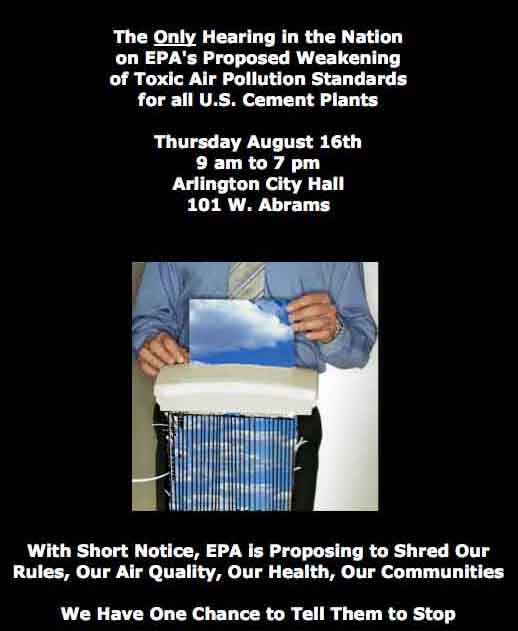Archive for August 2012
Thanks Much.
Thanks to everyone who showed-up on Thursday. More on Monday, but this will give you a run down on who spoke.
Citizens Plan to “Shred” EPA at Cement Plant Rules Hearing
 WHAT: The Nation's Only Public Hearing on the EPA's Rollback of Cement Plant Air Pollution Standards
WHAT: The Nation's Only Public Hearing on the EPA's Rollback of Cement Plant Air Pollution Standards
WHEN: 9am to 7 pm Thursday, August 16th
WHERE: Arlington City Hall, 101 W. Abram
(Arlington)—Opponents of an EPA proposal to rollback new cement plant air pollution standards will incorporate a paper shredder into their comments at an all day national EPA hearing at Arlington on Thursday.
"Sometimes words aren't enough to express your outrage. You need an action that speaks louder. Our shredder is pretty loud," said Downwinders at Risk Director Jim Schermbeck, whose group is leading an effort to recruit 100 speakers to fill every 5-minute speaking slot from 9 an to 7pm.
He and others plan to use the shredder to show the EPA what's at stake in the agency's last-minute reversal of key parts of the first ever national toxic air pollution emission standards.
They're bringing pictures of relatives with pollution-related illnesses, copies of the Clean Air Act, health care bills, and the EPA's iconic logo to feed into the shredder to help drive home the personal and public effects of the agency's proposed two-year delay and increase in soot pollution.
"With this regulatory mugging, EPA is shredding air quality, it's shredding public health, its shredding public confidence. We're just showing the results," said Schermbeck.
Despite only 11 days notice for a national hearing in the middle of August, he predicts citizens will come close to meeting their goal of filling all available speaking slots. It's the only hearing EPA is holding as it considers the changes to the original federal 2010 cement plant pollution standards that were hailed by the same groups now protesting a retreat.
Groups are expected to be joined in their rejection of the rollback by North Texas area elected officials or members of their staff, including Congresswoman Eddie Bernice Johnson, State House Representative Lon Burnam, Dallas County Judge Clay Jenkins, prospective Congressional Representative Mark Veasey, and State Senator Wendy Davis.
In 2009, approximately 90 people testified at a similar DFW hearing as the rules were up for final adoption. Dallas-Ft. Worth is downwind of the nation's largest concentration of cement plant manufacturing, with three large plants located within only a few miles of each other in Midlothian. The plants have been the center of environmental and health controversies since the late 1980's and made North Texas a hotspot of citizen opposition to industry pollution.
Having finally been adopted after 20 years of lawsuits, the new emission standards were on their way to be singed into law by President Obama this summer when EPA suddenly pulled them and announced they wanted to delay implementation from next year to 2015 while also loosening emission standards for Particulate Matter pollution. In evaluating the results of the revision, EPA admitted it will increase PM pollution from the nations cement plants by 135 tons a year.
Previous EPA studies had calculated how many lives would be saved by the standards. Citizens have seized on these estimates to now calculate the harm of the agency's two-year delay, putting the national death toll at between 2-5,000 lives using the EPA's own numbers.
Because of the amount of pollution generated in Midlothian and the population density of DFW, a significant portion of those deaths will be local residents.
No court ordered the after-the-fact revisions. In fact, the rules had survived their very last court challenge last December. Schembeck says that makes the rollback even more mysterious.
"EPA is going out of its way to deny citizens what they were on the verge of winning – the first ever federal air pollution standards for the nation's cement plants," Said Schermbeck. "They're robbing people who've been working on this issue for over 20 years for no good reason. We're not going to be quiet as they try to take away what we've rightfully earned."
Crohn’s Disease Linked to Lead Smelting Pollution
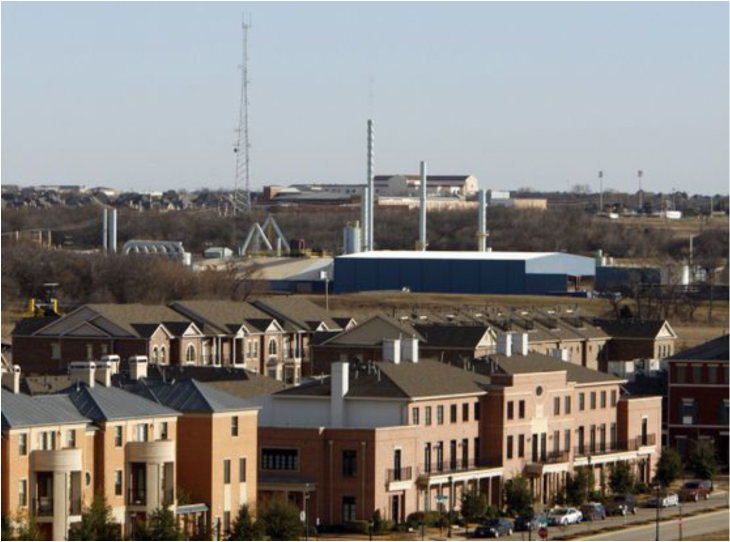 Ulcerative colitis and Crohn's Disease are similar debilitating diseases of the digestive system which can include symptoms like severe abdominal pain and diarrhea. About a million and a half people in the US have the condition, which many researchers now believe to be linked to environmental causes.
Ulcerative colitis and Crohn's Disease are similar debilitating diseases of the digestive system which can include symptoms like severe abdominal pain and diarrhea. About a million and a half people in the US have the condition, which many researchers now believe to be linked to environmental causes.
A Harvard Medical School study recently added to the evidence of such a link when it identified a cluster of suffers in extreme northern Washington state who live in proximity to an old lead and zinc smelter on the other side of the US-Canadian border. That smelter has been the source of complaints about pollution in the US as far back as the 1930's, when compensation for pollution damage was recommended by the Border Commission. Harvard doctors, including lead researcher Dr. Josh Korzenik, asked approximately 120 former and current residents of Northport, Washington to take a health survey. 17 of them had Ulcerative colitis or Crohn's.
“That’s about 10 to 15 times what we’d expect to see in a population the size of Northport,” said Korzenik, director of the Crohn’s and Colitis Center at Brigham and Women’s Hospital, one of Harvard Medical School’s teaching hospitals. “I’m not aware of any other cluster like it.”
But that could be because no one has looked. What kind of health survey logistics would it take to bring a similar study to Frisco, where emissions from the Exide lead smelter have been coating the surrounding areas for almost 50 years? Who would think that these symptoms could be linked to smelter emissions? Respiratory problems, IQ and developmental issues, even deafness, but not chronic stomach ailments. This is just one more disease that Frisco residents will have to try to determine if the Exide smelter is leaving behind as part of its toxic legacy.
Industry’s Man in the White House
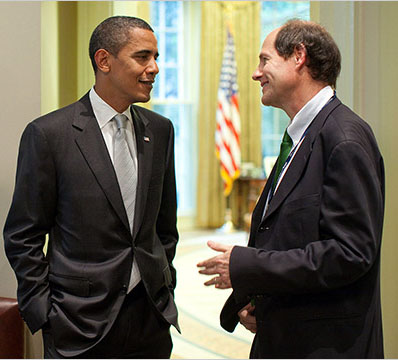 Not very many citizens realize the process that proposed environmental regulations have to go through in any administration in order to get out and published in he Federal Register in one piece. Not only does the regulation have to pass through the EPA's own cost-benefit analysis and survive various Congressional and court challenges, it must also pass through a murkier and more subjective test administered by the Office of Management and Budget, or OMB.
Not very many citizens realize the process that proposed environmental regulations have to go through in any administration in order to get out and published in he Federal Register in one piece. Not only does the regulation have to pass through the EPA's own cost-benefit analysis and survive various Congressional and court challenges, it must also pass through a murkier and more subjective test administered by the Office of Management and Budget, or OMB.
OMB is the very last stop an environmental regulation makes. There are no environmental scientists at OMB to judge the necessity of the regulation. No, OMB's job is to make sure the regulation doesn't hurt industry too much. That may seem like a worthwhile goal, but without any kind of strict guidelines for how to judge that, the conclusion is often open to a lot of interpretation. Industry knows that OMB is its last shot at stopping a regulation that otherwise has broad support form the public and even EPA. Among the non-profit environmental activists in DC, OMB is known as the place regulation go to die.
That's how last year's decision to leave the new ozone standard at 75 parts per billion, rather than the 70 ppb that EPA scientists had advocated – got done. Same thing for a weaker Particulate Matter standard this year. And we can't prove it yet, but we bet OMB had something to do with the rollback in cement plant emission rules being proposed suddenly by EPA/.
The face of the Obama Administration's OMB has been Cass Sunstein, head of the OMB's Office of Information and Regulatory Affairs (OIRA), a powerful department that holds sway over federal agency rulemakings. Having done his damage in the first Obama Administration, he recently announced he was leaving his job and returning to academia. But not before the DC publication "The Hill" got its hands on the e-mails Sunstein sent on behalf of the US Chamber of Commerce to get last year's ozone pollution standard weakened. In effect, he becomes a lobbyist on behalf of industry within the administration after industry has already lost the public health debate.
"The response to The Hill’s FOIA request shows Sunstein played an active role in alerting White House aides to business’s concerns about tightening the ozone standards. Internal communications show that ahead of the September decision, Sunstein circulated strong criticism of the ozone rule from a pair of powerful business groups, the National Association of Manufacturers (NAM) and the Business Roundtable, as well as House lawmakers opposing the tougher standards."
On July 15 of last year, Sunstein sent DeParle and two other aides a copy of a letter from the Business Roundtable to Daley, saying it was “worth reading.” The business group also released the letter publicly at the time.
On July 26, Sunstein sent a wider group of aides — including senior energy adviser Zichal and Phil Schiliro — a column titled “The Latest Job Killer From the EPA” that Business Roundtable President John Engler penned in The Wall Street Journal.
An un-redacted portion of the message from Sunstein states, “I am sure you saw this but just in case.
On Wednesday, Aug. 31, Sunstein forwarded several aides — including Stephanie Cutter, now a top Obama campaign official — an op-ed that NAM President and CEO Jay Timmons penned in The Hill attacking the ozone rule."
Possible New Catalyst for Methane Capture in Cars and Gas Field
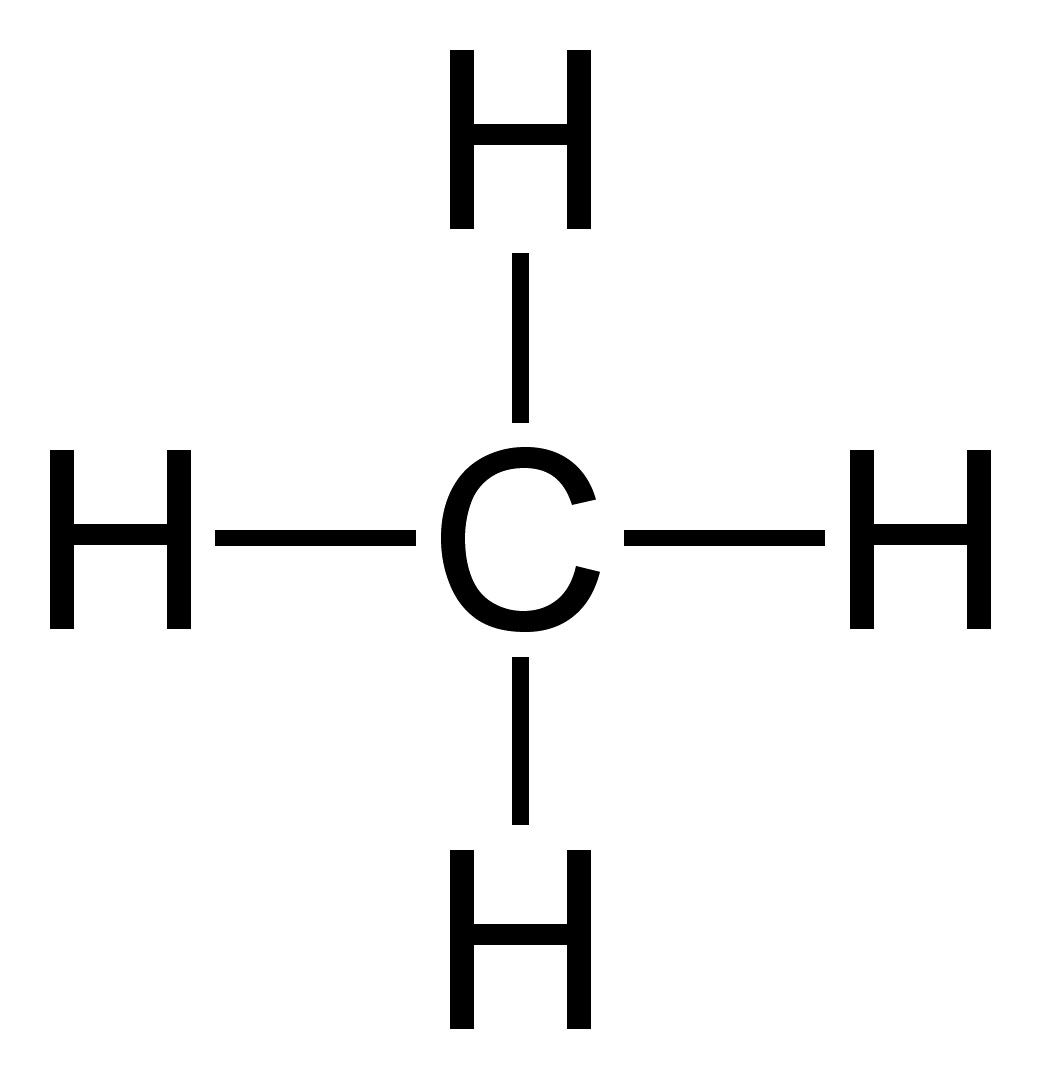 Via Chemical and Engineering News comes word that scientists from the University of Pennsylvania and the University of Trieste in Italy have developed a new low-temperature catalyst material that could remove methane emissions form vehicles as well as many different gas and oil field facilities. It would work the same way your car's catalytic converter works now – you force the emissions through a cylinder web or screen coated with a chemical designed to pick up specific molecules.
Via Chemical and Engineering News comes word that scientists from the University of Pennsylvania and the University of Trieste in Italy have developed a new low-temperature catalyst material that could remove methane emissions form vehicles as well as many different gas and oil field facilities. It would work the same way your car's catalytic converter works now – you force the emissions through a cylinder web or screen coated with a chemical designed to pick up specific molecules.
In the past, this process didn't work with Methane until you reached higher temps than are usually found in a car's engine. The breakthrough being reported solves that problem by allowing the capture of methane to take place at lower temperatures. Still in the testing phase, but we need to be on the lookout for better ways to capture methane pollution, which has been found to be something like 26 times more destructive to climate change per ton as CO2.
"Edman Tsang of Oxford University, an expert on catalysis and clean energy, says: “There is a tremendous need to remove small amounts of methane from the exhausts of gas turbines and internal combustion engines and from flue gases in petrochemical and related industries. The generally low activity of conventional catalysts and their instability at high temperatures” have made it difficult to meet this challenge, whereas the new catalyst makes a first step toward a solution. The approach needs further assessment but provides “a clear direction” for future research, he says."
Halfway Point for Thursday EPA Hearing: 50 speakers signed-up, 50 more needed
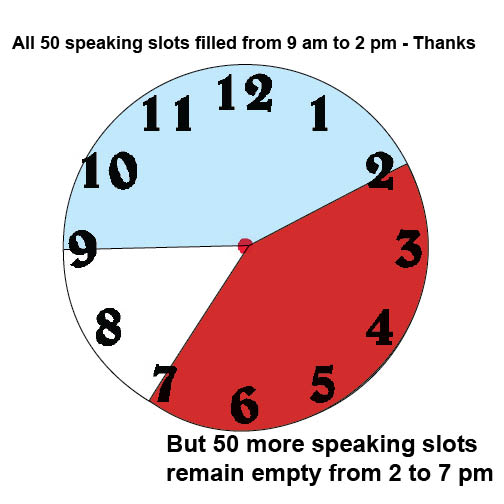 The Nation's Only Public Hearing on the Weakening of Toxic Air Pollution Emission Standards for All U.S. Cement Plants
The Nation's Only Public Hearing on the Weakening of Toxic Air Pollution Emission Standards for All U.S. Cement Plants
Thursday August 16th
9 am to 7 pm
Arlington City Hall
101 W. Abram
We've been able to sign-up 50 speakers in less than a week for national hearing on short notice – Thank You
– EPA is proposes to weaken the cement plant standard for Particulate Matter pollution, or soot, and no longer use real time monitoring of PM pollution to enforce that standard.
Talking Points for Thursday's Hearing
legislation to delay and weaken the cement standards failed in Congress after finding scant support in the Senate. Under these circumstances, it's a mystery why EPA would propose to weaken and the delay the rules now.
Our request is simple: We want the original rules, and we want them implemented on the original schedule – next year.
|
How to Reserve Your 5-Minute
Speaking Slot on the 16th:
E-mail the EPA's Pam Garrett at garrett.pamela@epa.gov or call her at
(919) 541-7966. She'll assign you a specific time.
|
|
|
|
The Day After
 The winds found DFW again on Thursday night around 8 pm or we might have seen triple digit ozone concentrations up until the late news came on.
The winds found DFW again on Thursday night around 8 pm or we might have seen triple digit ozone concentrations up until the late news came on.
10 monitors recorded numbers that were among their four highest readings of the year. 9 recorded exceedances for the 1997 85 parts per billion ozone standard.
Rockwall had the day's highest readings by far – with an 8-hour average of 109 ppb, followed by Greenville with 97ppb, with Dallas Executive Airport (Redbird), Hinton Street, Arlington and North Dallas monitors all recording concentrations in the 90's.
For two monitors – Arlington Airport and Executive Airport – those exceedances were their fourth, and so official, violation of that '97 standard. That makes five monitors in 2012 that have crossed that line so far, and we're not out of August yet. Three more monitors are only one more bad day away from reaching the same place.
We'd already officially failed meeting the 1997 standard back in June to maintain our "non-attainment" status with the Clean Air Act for the 21st year in a row. Now we're just seeing how bad that non-attainment is this year.
One more thing. The two monitors that have historically been the hardest to bring down to legal levels – Eagle Mountain Lake and Keller – are not among those five 2012 non-attaining monitors to date, although they're on the brink. Both are located in the Northwest part of DFW. For a couple of years they were the only monitors that were in violation. This was taken as a good sign, because illegal levels of smog were confined to that corner of the Metromess that was downwind of everything in DFW, at the tail end of the ozone-producing process. It was thought if we could just get these two monitors in compliance, we'd finally see safe and legal air in DFW.
But as of August 10th, all five violating monitors are located to the east, or upwind, of these Eagle Mountain Lake and Keller monitors. The violating monitor furtherest east – Hinton Street at I-35 and Mockingbird – hadn't tripped since 2005. This year it was the first to go over the cliff. That's an indication that things are not proceeding as planned.
Last year we had the worst summer for ozone since 2007. But it was a year of record-breaking drought, and you could have plausibly used that condition as an excuse to claim an exception. This year, the drought was broken, but air quality continues to deteriorate. We're going the wrong way, but no one in officialdom will say so.
Please Take 5 Minutes to Defend What it Took Us 20 Years to Build
Wake-Up and Breathe the Air Quality Progress/ Update X2
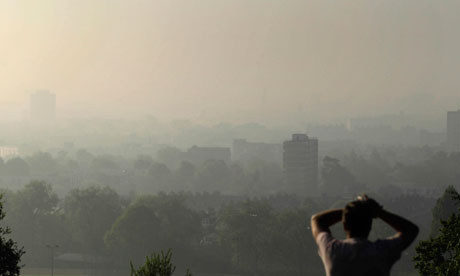 6:00 pm Update: Rockwell hasn't hit 125 ppb yet, but it's hovered in the "red" high teens for three hours according to the latest update from TCEQ, which only goes up to 4 pm. Frisco, Arlington Airport and the old Redbird Airport monitors still seem likely to have their fourth and so, official violation the 1997 ozone standard of no more than 85 ppb for an eight hour stretch.
6:00 pm Update: Rockwell hasn't hit 125 ppb yet, but it's hovered in the "red" high teens for three hours according to the latest update from TCEQ, which only goes up to 4 pm. Frisco, Arlington Airport and the old Redbird Airport monitors still seem likely to have their fourth and so, official violation the 1997 ozone standard of no more than 85 ppb for an eight hour stretch.
3:30 pm Update: In the time it took to write this, Rockwall has seen its ozone levels rise to 119 parts per billion. The very old original ozone standard was 125 ppb over a one-hour period. That's considered not just a red alert day – that's getting deep purple. We already had one of those in Arlington in June. Rockwall is on its way.
Original Post:
DFW's luck with the wind has ended.
Breezes have slowed and pivoted to the East, carrying coal plant and natural gas mining pollution. At 11 am the Rockwall smog monitor was already at 91 parts per billion; the next hour it was 111 ppb. The new federal standard is 75 ppb. Now a broad front of five monitors are in the 90's, from Frisco to Arlington. Of those five, two are just one more "exceedance" of the old 1997 standard of 85 ppb – a standard that despite two clean air plans from Austin, DFW has never managed to meet. if they trip today, that would bring the total number of DFW monitors officially out of compliance with that '97 standard to five.
As late as last December, the Texas Commission on Environmental Quality was maintaining with a straight face that there would be NO MONITORS OUT OF COMPLIANCE WITH THE 1997 OZONE STANDARD. Whenever you'd point out that we just had the worst year for ozone since 2007, or that such a goal would require the lowest ozone levels ever recorded in DFW, TCEQ staff would shrug their shoulders and say, "That's what the computer model tells us," as if that was that. In their own way, TCEQ has become the technocratic equivalent of those who beleive in the inerrent word of the Bible. The Bible Says It, I Believe It, and That Settles It. Substitute the word "model" for "bible," and you have the philosophy driving the TCEQ response to DFW's chronic dirty air. 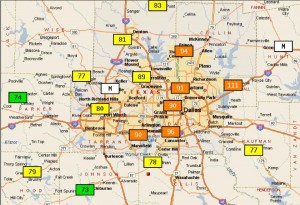
Of course, it matters what variables you put in that model, and how much weight you assign them, and how you run it. And if you're an extension of Rick Perry's permanent campaign machinery. In that case, the model has to say things will get better – because otherwise your critics would say the state needs EPA help to clean up the air; needs to not recommend new pollution control measures – because otherwise it would contradict your anti-government crusade; and needs to ignore the most potent source of new emissions in the last 20-30 years from what is historically the most powerful industry in Texas.
If you have all that going for you, well then why sure, every summer is a new chance to once again prove how the invisible hand of the marketplace can take care of everything. And if it doesn't? Well, it was the EPA's fault for interfering with the marketplace. You can never lose.
The biggest purveyor of junk science in Texas is TCEQ. It's become exactly what it criticizes. Local DFW governments say they are dependent on the agency to provide them with "expertise" they just can't afford. But what's the value of that expertise when: 1) It's always wrong, and, 2) TCEQ is acting directly against local interests by letting ideology trump good science?
In 2010, just one or two monitors were violating the 1997 standard. Last year it was seven. By the end of the day today it could be five. The smog is getting thicker, and TCEQ is playing with its inerrant models.
Government Toxicity Test Misses Real World Reactions
 Just last week we were posting about the cumulative impacts of air pollution that are never taken into account by EPA risk assement. Now a new University of North Carolina study concludes that the toxic soup of chemicals and particulates found in many metropolitan areas is more harmful to human health than a common test used by government often reveals.
Just last week we were posting about the cumulative impacts of air pollution that are never taken into account by EPA risk assement. Now a new University of North Carolina study concludes that the toxic soup of chemicals and particulates found in many metropolitan areas is more harmful to human health than a common test used by government often reveals.
Researchers used a sunlit rooftop chamber to combine car diesel exhaust with a mix of Volatile Organic Compounds (VOCs) simulating urban air. They compared two methods for measuring the concoction’s toxicity: directly exposing human lung cells to particulates in chamber air with an electrostatic system, and a widely used method – that filters the air, resuspends the filtered particulates in a solution, and then applies this mixture to lung cells.
The cells directly exposed to the mix in the chamber experienced inflamation, whereas those that went through the filtering process did not. Based on analysis, scientists attributed the difference in reaction to semivolatile carbonyl compounds, which coat particles in air but are lost during filtration. Formaldehyde is one such carbonyl compound. Sunlight hitting VOCs in the atmosphere can create carbonyl compounds and coat very small soot particles, or Particulate Matter, suspended in air with the pollutants. When you breathe in the soot, you actually breathe in a tiny delivery device for these kinds of pollutants as well.
No risk assessment process incorporates these kinds of real world health impacts and it's just one reson why these assessments are not good models for actual human health impacts from pollution.


